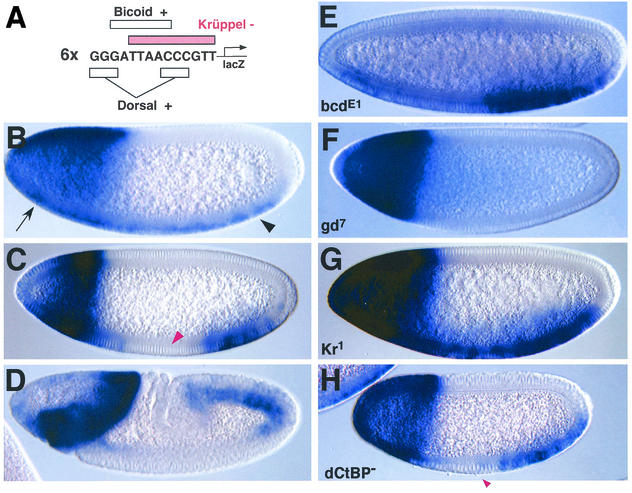FIG. 5.
dCtBP is not required for repression by competition. (A) Sequence of the synthetic enhancer. Six tandem copies were attached to a minimal eve-lacZ reporter gene. The exact binding sites for Bicoid, Dorsal, and Krüppel are indicated. (B to D) lacZ expression in wild-type (yw) embryos at nuclear cycle 12 or 13 (B), mid-cycle 14 (C), and germ band elongation (D). Transgenic embryos were hybridized with a digoxigenin-labeled lacZ antisense RNA probe. They are oriented with the anterior side to the left and the dorsal side up. The transgene is activated by Bicoid in anterior regions (B, arrow) and by Dorsal in ventral regions (B, arrowhead). Staining is repressed in central regions by Krüppel (C, red arrowhead). (E to G) The transgene was introduced into bicoid, gd, and Krüppel mutants (panels E, F, and G, respectively). There is a loss of staining in anterior regions in bicoid mutants (compare panels C and E). The reduced staining in anterior regions of the ventral mesoderm is probably due to the anterior expansion of the Krüppel staining pattern in bicoid mutants. In gd7 mutants, lacZ staining is lost in the ventral mesoderm (compare panels C and F). The central gap formed in wild-type (yw) embryos (C) is derepressed in Kr1 mutants (G). (H) The bicoid-dorsal-Krüppel-lacZ transgene introduced into dCtBP mutants. The central gap in the staining pattern is not lost (H, arrowhead; compare panels H and C). This result suggests that dCtBP is dispensable for the Krüppel-mediated repression of the synthetic enhancer.

